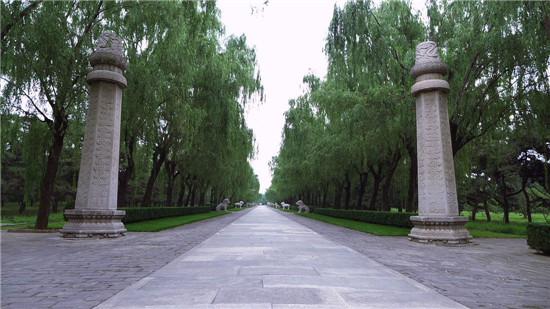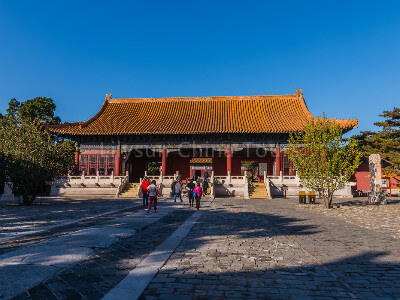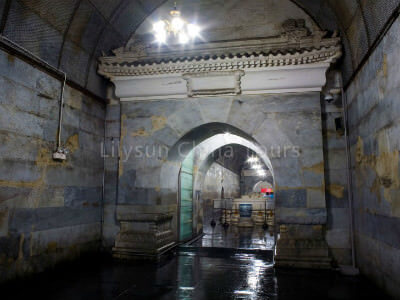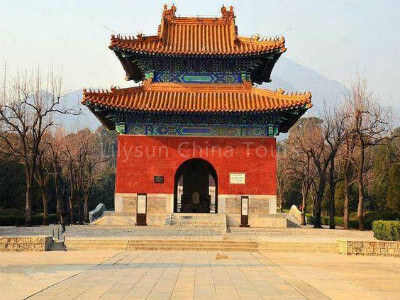Xian Tours
Beijing Tours
China Tour Packages
About
Covering 120 square kilometers and located at the foot of Tianshou Mountain in the Changping District, the Ming Tombs were built in a valley surrounded by mountains and clear waters with greatly beneficial Chinese Fengshui. These are the tombs of 13 Ming emperors, 23 empresses, and many imperial concubines, crown princes and princesses after the Ming Dynasty (1368-1644) moved its capital city to Beijing. The unique ensemble of cultural landscapes is evidence of a cultural and architectural tradition that surpassed the Ming Dynasty and had an everlasting impact on Chinese history.
As the largest existing and best preserved of imperial tombs, the Ming Tombs was inscribed as an important heritage site under state protection in 1961. In 1991, it was enlisted in the 40 best tourist attractions of China by the National Tourism Administration. In July 2003, it was inscribed on UNESCO's World Heritage List.
The thirteen tombs are successively Chang Mausoleum, Xian Mausoleum, Jing Mausoleum, Yu Mausoleum, Mao Mausoleum, Tai Mausoleum, Kang Mausoleum, Yong Mausoleum, Zhao Mausoleum, Ding Mausoleum, Qing Mausoleum, De Mausoleum, and Si Mausoleum. Currently, only the Sacred Way, Changling Tomb, Dingling Tomb and Zhaoling Tomb are accessible to the public. The thirteen tombs are similar in architectural style and overall arrangement but different in size and complexity. Each tomb was built in a piedmont and has a forecourt where memorial ceremonies and sacrifices were held. The design of the Ming Tombs focused on the harmony of mausoleums with water, plants and nature.
The Sacred Way is the main way leading to the thirteen imperial tombs inside the scenic area.  It is lined with more than 30 lifelike stone figures and horses, all sculptures based on a single huge rock. The arrangement of the stone sculptures indicates that emperors could still rule anything after death. A "Great Red Gate” consisting of three-arches stands at the front of the path. Along the 7 meter-wide Sacred Way, the Five-arch Bridge and many other well-arranged structures were built from south to north, presenting the magnificent splendor of the imperial power of the Ming Dynasty.
It is lined with more than 30 lifelike stone figures and horses, all sculptures based on a single huge rock. The arrangement of the stone sculptures indicates that emperors could still rule anything after death. A "Great Red Gate” consisting of three-arches stands at the front of the path. Along the 7 meter-wide Sacred Way, the Five-arch Bridge and many other well-arranged structures were built from south to north, presenting the magnificent splendor of the imperial power of the Ming Dynasty.
The Chang Tomb is the largest of the tombs and is the burial place of the  Yongle Emperor Zhu Di, the third Ming emperor and his empress Xu. Built in 1413, it is the best-preserved of the thirteen tombs. The Chang Mausoleum occupies 120, 000 square meters with the layout being square at the front and round at the back. There are three successive courtyards equipped with a mausoleum gate, kitchens, storerooms, an exquisite bas-relief depicting surging seawaters, a treasured hill, seahorses and two vigorous dragons. The lofty Ling’en Hall was built for enshrining memorial tablets of emperors and empresses and sacrificial activities during both the Ming and Qing dynasties.
Yongle Emperor Zhu Di, the third Ming emperor and his empress Xu. Built in 1413, it is the best-preserved of the thirteen tombs. The Chang Mausoleum occupies 120, 000 square meters with the layout being square at the front and round at the back. There are three successive courtyards equipped with a mausoleum gate, kitchens, storerooms, an exquisite bas-relief depicting surging seawaters, a treasured hill, seahorses and two vigorous dragons. The lofty Ling’en Hall was built for enshrining memorial tablets of emperors and empresses and sacrificial activities during both the Ming and Qing dynasties.

Seated at the foot of Dayu Mountain to the southwest of the Chang Mausoleum and occupying about 182,000 square meters, the Ding Mausoleum took 6 years to build from 1584 to 1590. It is the mausoleum for Zhu Yijun (1563-1620, the 13th Emperor of the Ming Dynasty) and his two Empresses. There are three successive spacious courtyards in the front, and an additional tall Gate Tower at the back of the mausoleum. It is the only mausoleum in the Ming Tombs which has been excavated for scientific research as well as for visiting and more than 3, 000 precious articles have been unearthed.
The Zhaoling Tomb was for the twelfth emperor and his three  queens in the Ming dynasty. It was the first large scale repaired tomb of the Ming Tombs located at the eastern foot of the Dayu Mountain. The Zhaoling Tomb spans an area of 35,000 square meters. The existing buildings include the Ling En Gate, a standing stele without inscriptions, the Ling En Hall, two side halls, a square gate tower and the Ming Pavilion. In addition, in some halls and pavilions, offerings and instruments of that era are exhibited as well as historical materials about the emperor and empresses of the mausoleum, and the Imperial Tombs’ Regulations.
queens in the Ming dynasty. It was the first large scale repaired tomb of the Ming Tombs located at the eastern foot of the Dayu Mountain. The Zhaoling Tomb spans an area of 35,000 square meters. The existing buildings include the Ling En Gate, a standing stele without inscriptions, the Ling En Hall, two side halls, a square gate tower and the Ming Pavilion. In addition, in some halls and pavilions, offerings and instruments of that era are exhibited as well as historical materials about the emperor and empresses of the mausoleum, and the Imperial Tombs’ Regulations.
Location: in the valley at the south foot of the Tianshou Mountain, Changping District, 50 km south east of Beijing City.
Opening time:
- 08:00-17:30 for Sacred Way;
- 08:00-17:00 for Zhao Mausoleum;
- 08:00-17:30 for Ding Mausoleum;
- 08:00-17:30 for Chang Mausoleum, stop selling tickets at 17:00.
Best time to visit: autumnCopyright © 2019 Lily Sun China Tours International, Inc. Terms &conditions | Privacy Policy | Sitemap